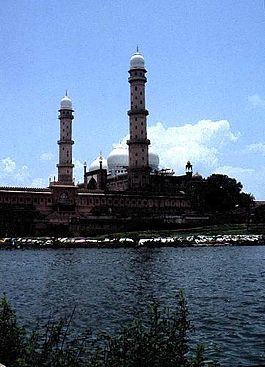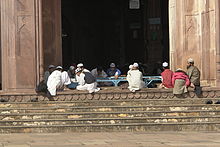- Taj-ul-Masajid
-
Taj-ul-Masajid 
Location Bhopal, India Branch/tradition Hanafi Deobandi Architectural information Style Mughal Dome(s) 3 Minaret(s) 2 Taj-ul-Masajid (literally: "the crown of mosques", also spelt as Taj-ul-Masaajid and Taj-ul-Masjid[1]) is a mosque situated in Bhopal, India. The mosque is also used as a madrasah (Islamic school) during the day time.
Contents
History
"Taj-ul-Masajid" literally means "The Crown of Mosques". The construction of the mosque was started by Sultan Shah Jahan, Begum of Bhopal (1868-1901). However, the mosque was not completed due to lack of funds, and after a long lay-off, construction was resumed in 1971 by great efforts of Allama Mohammad Imran Khan Nadwi Azhari of Bhopal.
Architecture
The mosque has a pink facade topped by two 18-storey high octagonal minarets with marble domes. The mosque also has three huge bulbous domes, an impressive main hallway with attractive pillars and marble flooring resembling Mughal architecture the likes of Jama Masjid in Delhi and the huge Badshahi Mosque of Lahore. It has a courtyard with a large tank in the centre. It has a double-storeyed gateway with four recessed archways and nine cusped multifold openings in the main prayer hall. The Quibla wall in the prayer hall is carved with eleven recessed arches and has fine screens of trellis work. The massive pillars in the hall hold 27 ceilings through squinted arches of which 16 ceilings are decorated with ornate petaled designs.
Dhai Seedi Ki Masjid
Dhai Seedi Ki Masjid ("The Mosque of Two and a Half Steps"), one of the smallest mosques in Asia,[2] is right across the road from Taj-ul-Masajid. It is on the campus of Gandhi Medical College (next to Hamidia Hospital). Dhai Seedi Ki Masjid is in one of the watchtowers. It is the oldest mosque in Bhopal city, initially built as a makeshift mosque during the construction of the Fatehgarh fort started by Dost Mohammad Khan. It was built so that the guards deployed at Fatehgarh Fort could perform Namaaz.
Annual Congregation
Aalmi Tablighi Ijtima, (an annual three-day congregation) that draws people from all over the world was held at Taj-ul-Masajid. But due to the shortage of space, it has been to shifted Ghazi pura, a place outside the city.
Gallery
References
- ^ The name is also spelt as Taj-ul-Masjid. The correct word is Masajid and not Masjid. "Masajid" means "mosques" (plural of "masjid") and "Taj-ul-Masajid" literally means "Crown Among Mosques")
- ^ "Bhopal Tours". http://www.destinationindiatourism.com/india-tour-destinations/bhopal-tours.html. Retrieved 2007-03-12.
Adina Mosque • Aasfi Masjid • Atala Masjid, Jaunpur • Babri Mosque • Charminar, Hyderabad • Chempittapally • Cheraman Juma Masjid • Old Jumma Masjid of Kilakarai • Goripalayam Mosque • Gyanvapi Mosque • Haji Ali Dargah • Hazratbal Shrine • Jama Masjid, Agra • Jama Masjid, Bijapur • Jama Masjid, Delhi • Jama Masjid, Fatehpur Sikri • Jama Masjid, Jaunpur • Jama Masjid, Mumbai • Jamia Masjid, Srinagar • Judi Mosque • Juma Masjid, Pullancheri • Lal Masjid, Delhi • Malik Dinar Mosque • Mampuram Mosque • Makkah Masjid, Hyderabad • Mishkal Mosque • Moti Masjid (Delhi) • Mubarak Mosque (Qadian) • Nakhoda Masjid • Odathil Palli • Palayam Juma Masjid • Panbari Mosque • Sidi Bashir Mosque • Sidi Saiyyed Mosque • Sir Syed Masjid • Taj-ul-Masajid • Thazhathangady Juma Masjid • Thousand Lights Mosque • Tipu Sultan Mosque Category – Mosques by country
Category – Mosques by country
Categories:- Mosques in India
- Visitor attractions in Bhopal
Wikimedia Foundation. 2010.




